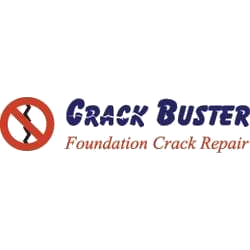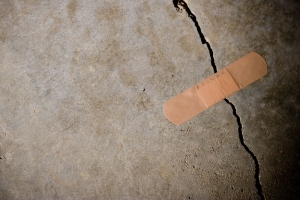IS IT A FANCY BAND-AID?
At Crack Buster we do most of our foundation crack repairs from inside. A question we are sometimes asked is, is it just a fancy band-aid? The short answer is no. If the answer was anything else, we would have a tough time staying in business as we offer lifetime-guaranteed repairs.
I have found that it is often our competitors who do outside repairs putting this question on the lips of our clients. It is important to note, however, that the way many people do inside repairs is indeed that notorious fancy band-aid. It is in fact, critical that a seal be accomplished at the outside of the foundation. Let’s dig in to this a bit.
There are many ways to tackle foundation repairs. Leaving aside structural repairs and external waterproofing, there are still three general categories of inside repairs. The least effective of these are patches. No sort of patch that exists only on the inside is going to hold up to the test of time. Any seal that is only on the inside is eventually going to fail as water that is allowed to seep into the back of the crack will eventually make its way around whatever has been done in front. This would be an example of a fancy band-aid. A second style of repair allows water to enter the house but drains it away with interior weeping tile. The third category is injection repair. Different types of injections are appropriate for different sorts of repairs. Epoxy injection is not a good option for vertical crack injection, for the very reason it is a reasonable choice for horizontal crack injection, namely its rigidity. Horizontal cracks, unlike vertical cracks, represent a failure of the structural integrity of the foundation wall, so epoxy is often chosen for injection as a means of reinforcement. In terms of preventing water penetration though, it is not recommended. Concrete expands and contracts with changes in temperature. A successful injection repair must be flexible enough to move with this expansion/contraction. Enter polyurethane.
There are many variations of polyurethane but the attributes that are relevant here are its expansive quality and its flexibility. The way many polyurethane (PU) injections are performed, injection ports are attached to the interior surface of the wall, sometimes after chipping a vee shape into the crack, and PU injected. Whether this is done with low pressure or high pressure, if the crack is less than ¼” wide, the PU is unlikely to reach the back of the crack outside. Thus, we again have a fancy band-aid.
At Crack Buster we drill small holes right on top of the crack, all the way through the wall, right to the soil outside. After prepping the crack for injection, we backflush so that a small pocket is created on the outside, then inject a PU resin that will expand 5 to 10 times to fully fill the pocket created outside and remain highly flexible once it sets. Thus, we have accomplished a seal to the outside as if we dug, but minus the physical labour and disruption to the landscaping.
Outside repair may be a good choice if there is an overall leakage/seepage problem with the foundation. This way, the entire foundation wall may be wrapped with a waterproof membrane, providing peace of mind, though usually at great expense. If, however, there are specific cracks or other deficiencies causing the foundation wall to leak, an interior repair is much more economical, and if done right, equally effective.



